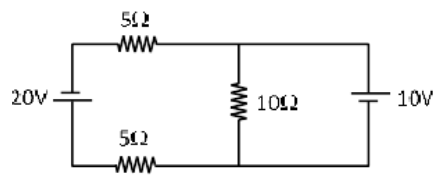Find V

10 V
20 V
30 V
None of these
The correct Answer is:A
Step by step video, text & image solution for Find V by Physics experts to help you in doubts & scoring excellent marks in Class 12 exams.
Updated on:21/07/2023Topper's Solved these Questions
- ELECTRONICSBOOK - ERRORLESS CHAPTER - ELECTRONICSEXERCISE - Digital Electronics
2 Videos
- ELECTRONICSBOOK - ERRORLESS CHAPTER - ELECTRONICSEXERCISE - Valve Electronics (Diode and Triode)
3 Videos
- ELECTRON, PHOTON, PHOTOELECTRIC EFFECT AND X-RAYSBOOK - ERRORLESS CHAPTER - ELECTRON, PHOTON, PHOTOELECTRIC EFFECT AND X-RAYSEXERCISE - Self Evaluation Test
3 Videos
- ELECTROSTATICS BOOK - ERRORLESS CHAPTER - ELECTROSTATICS EXERCISE - Ordinary Thinking Objective Questions (Electric Flux and Gauss.s Law)
28 Videos
Similar Questions
A uniform electric field exists in a region of space. Potential at potential O,A,B and C are V0=0 and VA=−1V,VB=−6V and VC=−3V respectively. Alll the cubes shown in fig have side length of 1m. ltbr> (a). Find VP−VQ
(b). Find the smallest distance of a point from O where the potential is −2V

View SolutionA ball moving with velocity V0, makes a head on collision with another identical ball at rest. The velocity of incident ball and the other ball after collision is V1 and V2 respectively.
(a) Using momentum conservation write an equation having V1andV2 as unknowns. Plot a graph of V1 vs V2 using this equation.
(b) Assuming the collision to be elastic write an equation for kinetic energy. Plot a graph of V1 vs V2 using this equation.
(c) The intersection point of the above two graphs gives solution. Find V1andV2 .
(d) In a particular collision, the plot of graphs mentioned above is as shown in figure

Find V1andV2 for this collision. Also write the percentage loss in kinetic energy during the collision.
View Solution
Knowledge Check
Find the value of VAB.
 A10 VB20 VC30 VDNone of these
A10 VB20 VC30 VDNone of theseIn uniform electric field E=10N/C, find

a. VA−VB , b. VB−VCA−10V and 20VB10V and −10VC30V and 20VD−10V and 40VFind current in 10V cell
 A2AB3AC4AD8A
A2AB3AC4AD8A
The position of a particle is given by
r=3tˆi+2t2ˆj+8ˆk
where, t is in seconds and the coefficients have the proper units for r to be in meters.
(i) Find v (t) and a(t) of the particles.
(ii) Find the magnitude and direction of v(t) and a(t) at t=1s.
View SolutionIn the p.m.f. of r.v. X

Find a
View SolutionGiven that v=√2GMR. Find log v.
View SolutionFind current through 4V battery

View SolutionFind the dimensions of V in the equation y=Asinω(xV−k)
View Solution
